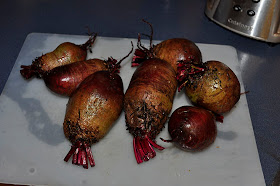According to the interwebs:
-
Garden-beet is very low in calories (contain only 45 kcal/100 g) and fat; but is very rich in dietary fiber, vitamins and minerals.
-
The root is rich source of phytochemical compound Glycine betaine. Betaine has the property of lowering homocysteine levels in the blood. Homocysteine, one of highly toxic metabolite, promotes platelet clot as well as atherosclerotic-plaque formation which is otherwise can be harmful to blood vessels. High levels of homocystiene in the blood results in the development of coronary heart disease (CHD), stroke and peripheral vascular diseases.
-
Raw beets are an excellent source of folates; contains about 109 mcg/100 g ( Provides 27% of RDA). However, extensive cooking may significantly depletes its level in food. Folates are necessary for DNA synthesis in the cells. When given during peri-conception period folates can prevent neural tube defects in the baby.
-
It contains significant amounts of vitamin-C, one of the powerful natural antioxidant which helps body scavenge deleterious free radicals one of the reasons for cancers development.
-
Beet’s green leaves (tops) are an excellent source of carotenoids, flavonoid anti-oxidants and vitamin A; contain these compounds several times more than that of in the roots.Vitamin A is required maintaining healthy mucus membranes and skin and is also essential for vision. Consumption of natural vegetables rich in flavonoids helps to protect from lung and oral cavity cancers.
-
The root is also rich source of Niacin (vit B-3), Pantothenic acid (vit.B-5), Pyridoxine (vit.B-6) and carotenoids, and minerals such as iron, manganese and magnesium.
-
In addition, this root veggie indeed has very good levels of potassium. 100 g fresh root has 325 mg of potassium or 7% of daily requirements. Potassium lowers heart rate and regulates metabolism inside the cells by countering detrimental effects of sodium.
On the last day of our mountain vacation a couple of weeks ago, AlmondBoy picked 3 pounds of beautiful beets from our friends' garden. I debated what to do with them. Mr. Marzipan loves borscht, but our host remarked upon how he enjoys pickled beets and so I figured it might be neat for him to get a jar of his own beets in the mail as a thank-you. They're also highly flavorful and make a great addition to salads, negating the need for high-fat condiments.

The morning after we got home from our trip, I cut the greens from the beets and trimmed the roots. It is important to leave the taproot intact when you're cooking beets or else all of the color will leach out. And leave the base of the leaves on as well, Basically, your beet should look rather like a human heart. Do not peel the beets. You'll slip the skins, roots, and tops off after they've cooked.


Place the beets in boiling salted water. They'll need roughly 30-40 minutes to cook, but you'll know they're done when you can easily poke a knife through.
While you are cooking and preparing the beets, make your pickling solution. Pickling solution is a high-acid brine that will preserve your food. It is not necessary to can these beets, and you can just keep them in the fridge if you like. But I like to cook in bulk when possible, so canning and freezing are handy. I used this recipe for the brine. It was heavenly. The recipe is for 1 pound of beets, and I had 3. I actually made a quadruple batch of solution to ensure I'd have enough to fill the jars. If you're not canning, a 1:1 ratio is fine.
Once they are sufficiently tender, remove the beets to the sink, drain, and allow to cool.
Once the beets have cooled enough, pick them up and slip the skins off with your fingers. It is very fun to do, actually.

Chop the beets into cubes.


If you are canning, put the cubes into the strained brine and bring back to a boil. If not, just pour the strained marinade over the beets and put everything in the fridge.
Canning The Beets
I don't have a high pressure canner yet and therefore use the open bath method. Which is a fancy way of saying I can using a big pot of boiling water. I also never got around to buying canning tongs and just use use two pairs of silicon-tipped kitchen tongs. It works find for me, but canning tongs really are better. When you do open bath canning, make sure the jars stay covered with water at all times or the pressure gradient will cause an explosion.
Here is a good link to canning beets. Scroll down to step 11 as the first 10 steps deal with trimming, cooking, and making the brine. (The brine recipe I used is vastly superior.) They have their brine and beets separate, but you can use your combined and boiling mixture.
My 3 pounds of beets yielded 5 jars. I apologize for not taking pictures of the brinemaking and the canning process, but I kind of forgot.